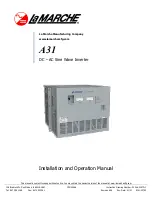
TECHNICAL INFORMATION
2001 Xantrex Technology, Inc.
5916 - 195th Street N. E.
Arlington, WA 98223
Telephone: 360/435-8826
Fax: 360/435-2229
www.traceengineering.com
SW Series Inverter/Charger
Part No. 2031-5
Rev. C: February 2001
Page
105
MONTHLY MAINTENANCE
At the minimum, check the level of the electrolyte in each battery cell once a month. It should be above
the top of the plates but not completely full. Most batteries have a plastic cup that the electrolyte should
just touch when full. Don’t overfill the batteries or the electrolyte will spill out of the batteries when they are
being charged. Only refill the batteries with distilled water - “spring” water and regular tap water may have
high levels of minerals that can poison the battery chemistry and reduce battery performance and life.
It is also good to check the battery interconnections for tightness and corrosion. If any corrosion is found,
disconnect the cables and carefully clean with a mild solution of baking soda and water. DO NOT ALLOW
THE SOLUTION TO ENTER THE BATTERY. Rinse the top of the battery with clean water when finished.
To reduce the amount of corrosion on the battery terminals, coat them with a thin layer of petroleum jelly
or anti-corrosion grease available from automotive parts stores or battery suppliers. Do not apply any
material between the terminal and the cable lugs - the connection should be metal to metal. Apply the
protective material after the bolts have been tightened.
BATTERY STATE OF CHARGE
A good estimate of a battery’s state of charge can be made by measuring the voltage across the battery
terminals with the battery at rest (No energy input, no energy output) for at least three hours. These
readings are best taken in the early morning, at or before sunrise, or in late evening. Take the reading
while almost all loads are off and no charging sources are producing power. Connect a voltmeter across
the positive and negative outputs of the battery or battery bank. Voltages are for a 12 volt battery system.
For 24-volt systems, multiply by 2; for 48-volt systems, multiply by 4. Monitor your cell voltage, if you
measure more than a 0.2 volt difference between each cell, you may need to equalize (Do not equalize
Gel Cell Batteries). The following table will allow conversion of the readings obtained to an estimate of
state of charge. The table is good for batteries at 77°F that have been at rest for 3 hours or more. If the
batteries are at a lower temperature, you can expect lower voltage readings.
Table 7, Battery State of Charge Voltage
PERCENT OF
FULL CHARGE
12 VOLT DC SYSTEM
CELL VOLTAGE
100%
12.7
2.12
90%
12.6
2.10
80%
12.5
2.08
70%
12.3
2.05
60%
12.2
2.03
50%
12.1
2.02
40%
12.0
2.00
30%
11.8
1.97
20%
11.7
1.95
10%
11.6
1.93
0%
<=11.6
<=1.93
Summary of Contents for SW Series
Page 151: ......















































